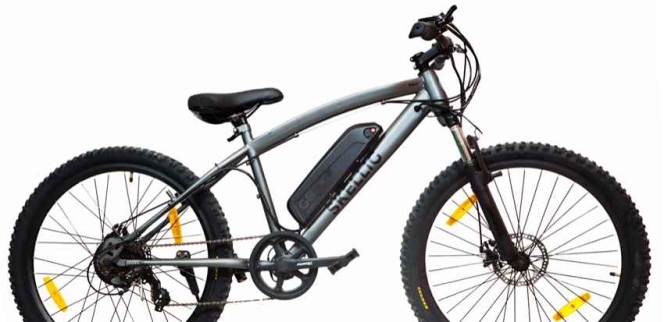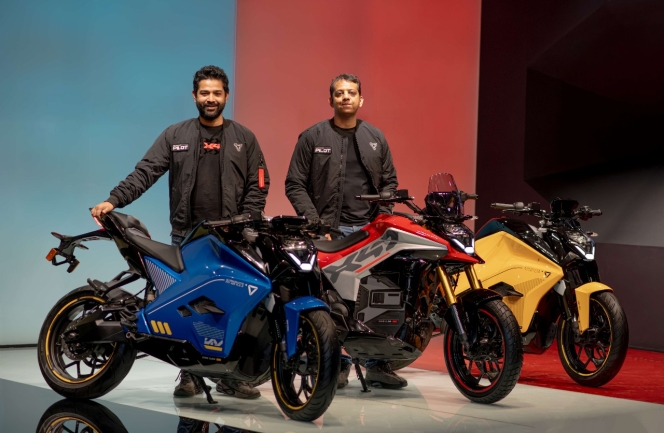GoZero Mobility To Focus On Mass Premium Market In India
- By Sharad Matade
- December 19, 2020

The launch of the new products is in line with the growing demand for e-bikes in India,triggered by the rising awareness of a healthy and active lifestyle. GoZero’s CEO, Ankit Kumar, said, “The pandemic has triggered and propelled the need for people to take health seriously. We have seen a sudden increase in e-bike sales globally. Our core aim at GoZero is to continuously develop exceptional products that become an aid for people to adopt an active lifestyle. We are launching the Pro version of Skellig, launching our Make.Fit series of active performance wear and releasing our new toll-free lines for our customers.”
Headquartered in Birmingham, the company entered the Indian market in April 2019 with the launch of two e-bikes. To introduce the products in the market, GoZero has partnered up with Kirti Solar based in Kolkata, for the development and manufacturing of current and future products, utilising the global supply chain to “Make in India”. As a part of the association, Kirti Solar has invested USD 250,000 in GoZero Mobility.
Skellig is powered by the EnerDrive 210Wh lithium battery pack (800 cycles), 250W motor and comes with several modes including Throttle Mode, 5-level Peddle-Assist Mode, Walk Mode, and Cruise Mode. The model has an alloy stem handle and features 26x1.95 tyres and a premium counter-body suspension fork.
Skellig Lite combines the EnerDrive 210 Wh lithium battery pack (800 cycles) and 250W motor with three modes. It features an alloy stem handle, with 26x1.95 tyres, specialised V-brakes and an independent rigid suspension fork. Both the models have a maximum speed of 25 kmph with a range of 25 km on a single charge.The EnerDrive Battery packs can be charged in just 2.5 hours.
The company has also introduced a Pro version which is a hybrid e-bike for off-roading and city commute both. Powered by EnerDrive 400 Wh lithium battery pack (2000 cycles), it is supported by a composite mild steel frame, 7-speed gear system with an advanced front suspension fork, an alloy stem handle and disc brakes for both wheels.
Besides, it has Control Version 4.0 LCD and a flashlight with a guide-me-home enabled lighting system. The maximum speed of this model is 25 kmph and powers through for 70 km range in a single charge, which takes around three hours to recharge from 0-95 percent.
According to Kumar, the e-bike market in India is growing three folds every year. Last year 6,000 units were sold, of which the company had a share of 30 percent. This year, the industry sees tremendous growth due to focus on health and social distancing, clocking around 19,000 units. Though the e-bike is a niche market, it fits in between two segments-the bicycle and the two-wheeler industry, which have a sales volume of 16 million and 21 million units, respectively.
“E-bikes become the right option for both types of consumers- first who want to an e-bike for commute and do not want pay big amounts on scooters or motorcycle and for those, a larger group, who want e-bikes for commuting purpose and healthy lifestyles as well. We focus on to offer the right mix of technology, cost and quality,” said Kumar.
Skellig and Skellig Pro, are being sold through online and offline routes, while the Skellig Lite is being sold through online platforms. About 75 percent of the sales comes from offline, while the rest comes from online portals.
After launching of its two models, the One and the Mile, last year, the company realised that there are larger numbers of people who want to buy an e-bike in the range between INR15,000 to INR 20,000. However, there is no company which offers e-bikes in that range. Therefore, it launched Skellig Lite for INR 19,999.
To expand business, the company is doubling its dealers to 100 by January 2021. The company is taking entrepreneurs on board, and the programme is called direct sales partners. Explaining this programme, Kumar said, this is for individuals who have a passion for sales and wants to start their own business but does not have capital. “If a person has sales experience, he can join us as a direct sales partner. We give him/ her all collaterals- the marketing materials-and if the person cracks a deal with an individual or a corporate, the direct sales partner gets a commission. They don’t need to keep an inventory.”
As of now, the company has over 100 direct sales partners and, in the last three month, it has converted seven direct sales partners into the dealers.
The company is also expanding its experience centres in India from three to five soon.
Kumar said, “Our dealers get a margin of up to 16 percent on e-bikes and we also offer good margins on the active performance wears which have been launched by the company recently.”
The company gives a warranty of two years on each e-bike and provides two free services in the first year. The company is increasing local authorised technicians, whose data will be updated soon on the company website, to have e-bike serviced at home. It is also working on having partnerships with service providers such as GO Mechanic to avail services where the company dealers and technicians are not available as of now.
On the possibility of price reduction, Kumar said, “We will be trying to reduce the prices of our products further, but there is a threshold. We cannot bring down the prices after one level as we do not compromise on the quality of our e-bikes. Main costs of any e-bikes come from batteries, motors, and controllers. Until India does manufacture cells and make batteries locally, it will be difficult to bring down the prices after a certain level.”
The company has a manufacturing unit near Kolkata with a capacity of 12,000 units per annum. To support speedy deliveries it is also exploring to build a facility in North India, which will have a capacity of 20,000 per year.The company is facing significant challenges on the logistic for delivery of the products due to COVID. According to Kumar, delivery time and cost have doubled thanks to COVID. “We do not see the logistic business will come back on track at least for the next one year and that is the one the reasons to open a plant in North so we can cater to north and west market more efficiently,” said Kumar.
Last year the company sold around 1,150 units, and for this year, it targets to sell about 2,000 units. “Due to the lockdown, we have revised our sales target from 3,000 units to 2,000 units for this FY.” Majority business for the company comes from south India, particularly, Hyderabad, Bengaluru and other cities, where technology adaption is faster.
To enhance e-bikes’ experience, the company has launched comfort apparels. Most of the amateur cyclists do not feel comfortable wearing skintight spandex. It has developed active gears, specifically design to bend tech with comfort and style. “We have introduced active gears which are comfortable and durable products and allows more breathability to users,” Kumar added. (MT)
Greaves Cotton Appoints Santosh Singh As Chief Strategy And AI Officer
- By MT Bureau
- December 16, 2025

Greaves Cotton has appointed Santosh Singh as Chief Strategy and AI Officer. He will be based in Mumbai and will lead strategy, transformation, AI-led enterprise capability building and business excellence for the Greaves Cotton Group.
Singh comes with over two decades of experience in strategy, business excellence, innovation, and AI-led enterprise transformation. He joins Greaves Cotton from Tata Technologies (TTL), where he served as Global Head – Marketing and Business Excellence. During his tenure there, he co-led the enterprise GenAI roadmap and developed use cases focused on customer engagement and productivity.
His primary mandate is to drive the Greaves.NEXT strategy, the company’s roadmap for growth across the energy, mobility and industrial solutions sectors.
In his new role, Singh will focus on accelerating growth for Greaves Technologies (GTL), developing an enterprise-wide AI roadmap, and establishing partnerships with hyperscalers and AI labs.
Parag Satpute, Managing Director & Group CEO, Greaves Cotton, said, “We are pleased to welcome Santosh to the leadership team. His extensive expertise in strategy, digital transformation, and AI will play a significant role in shaping Greaves’ next phase of growth. His global experience will further strengthen our innovation roadmap and support our long-term business priorities.”
Singh will also work across business units to incubate and scale growth vectors and lead business excellence initiatives.
Luminar Sells Photonics Division To Quantum Computing Inc For $110 Million
- By MT Bureau
- December 16, 2025

Luminar Technologies, Inc., a global technology company advancing safety, security and autonomy across various sectors, has announced it has agreed to sell its wholly owned subsidiary, Luminar Semiconductor, Inc. (LSI), to Quantum Computing Inc. (QCi) for USD 110 million in an all-cash transaction.
QCi is an integrated photonics and quantum optics technology company focused on photonics-driven technologies and sensing applications. LSI's innovation platform and engineering depth align with QCi’s strategic priorities in optical systems, chip-scale innovation and photonic architectures. The acquisition is expected to position LSI to grow and capitalise on the demand for photonics solutions.
Paul Ricci, CEO, Luminar, said, "We are pleased to partner with QCi as they continue to accelerate their photonics roadmap. QCi’s focus on photonics-driven technologies provides an aligned platform for LSI to expand its customer base, accelerate growth opportunities, and invest in markets where long-term demand for high-reliability optical systems is increasing. We are incredibly proud of the LSI team for the progress they have made to reach this milestone, and we are excited for the opportunities ahead for LSI under QCi’s ownership.”
Yuping Huang, CEO, Quantum Computing Inc, said, "I’m excited about the opportunity to partner with the exceptional team and valued customers of LSI. There is clear strategic alignment and shared vision between our organizations, creating strong momentum from day one. Following the closing, we will move quickly to invest in and scale LSI’s existing business, while bringing our teams together to accelerate our quantum photonics roadmap. This is a powerful combination, and I’m energized by what we will achieve together.”
In a separate announcement, Luminar announced that it has initiated voluntary chapter 11 cases in the U.S. Bankruptcy Court for the Southern District of Texas. LSI is not a debtor in the chapter 11 cases and is operating in the ordinary course. Because LSI is a subsidiary of Luminar, the transaction will require the approval of the bankruptcy court via a Section 363 sale process, which the parties expect to receive by the end of January 2026, subject to closing conditions.
Neusoft And MapmyIndia Partner For Intelligent Mobility Solutions
- By MT Bureau
- December 06, 2025

Chinese technology company Neusoft Corporation and Mappls MapmyIndia have signed a Memorandum of Understanding (MoU) to leverage their strengths in software and data resources to collaborate deeply.
The companies will engage in joint technological development, ecosystem collaboration and resource integration to provide navigation products and intelligent mobility solutions tailored to localised needs in emerging markets such as Southeast Asia and India.
The partnership is a response to the fact that while global auto brands are expanding into Southeast Asia and India, they face challenges in these regions due to complex road conditions, unique traffic rules, extensive addressing systems and high localisation adaptation costs. These issues limit the ability of automakers to deliver a complete intelligent user experience.
Under the collaboration, Neusoft will adopt its OneCoreGo Global Intelligent Mobility Solution 6.0 Plus as the core technology carrier, deeply integrating MapmyIndia's map data, real-time traffic information and multi-dimensional value-added services. MapmyIndia is noted as the largest local mapping company in India, holding more than 90 percent market share in in-vehicle navigation.
The integration is intended to strengthen a full capability loop of ‘navigation + payment + interaction + connectivity + operations’.
Through API integration and technological convergence, the two parties will jointly develop navigation products and mobility solutions highly adapted to Southeast Asia, India and similar regional markets. These solutions will deliver precise route planning and real-time traffic guidance, address local user needs and continuously enhance product experience and scenario-based services. This will help automotive partners rapidly launch intelligent vehicle models with competitiveness in local markets.
The partnership enables Neusoft to combine the global end-to-end strengths of its solution with localised ecosystem resources, paving the ‘last mile’ for automakers entering the Southeast Asian and Indian markets and delivering comprehensive intelligent mobility experiences.
- Ultraviolette Automotive
- Zoho Corporation
- Lingotto
- F77
- X-47
- Shockwave
- Tesseract
- Narayan Subramaniam
- Niraj Rajmohan
Ultraviolette Secures $45 Million Growth Capital From Zoho And Lingotto
- By MT Bureau
- December 04, 2025

Bengaluru-based electric vehicle maker Ultraviolette Automotive has secured USD 45 million from Zoho Corporation and Lingotto, one of Europe's investment management companies as part of its ongoing Series E investment round.
The investment from Zoho Corporation was led by Sridhar Vembu, Mani Vembu and Kumar Vembu.
This growth capital will accelerate the domestic and international scale-up of current products F77 and X-47, as well as future product platforms Shockwave and Tesseract.
Ultraviolette has built a design and technology-led enterprise with the F77 and the recently launched X-47.
The company has expanded to 30 cities across India in a short span of 12 months and is expanding to 100 cities by mid-2026. The F77 motorcycles were recently launched in the United Kingdom, bringing Ultraviolette's presence to 12 countries across Europe.
Narayan Subramaniam, Co-Founder & CEO, Ultraviolette Automotive, said, “We are glad to announce our Series E investment from Zoho and Lingotto. Lingotto's legacy of backing iconic performance and mobility brands, combined with Zoho's long-term commitment to fostering cutting-edge Indian innovation, aligns perfectly with Ultraviolette's mission to build category-defining electric mobility solutions for India and global markets.”
Niraj Rajmohan, CTO & Co-Founder, Ultraviolette, said, "With the ongoing Series E investments, we are doubling down on growth and expanding our production to meet increasing demand. Our focus is on advancing breakthrough battery technology, elevating performance capabilities and expanding production to support upcoming product platforms. This investment will accelerate our journey towards scaling into India and global markets."






Comments (0)
ADD COMMENT